
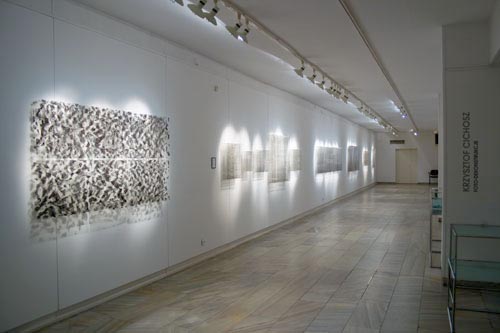
View from exhibition
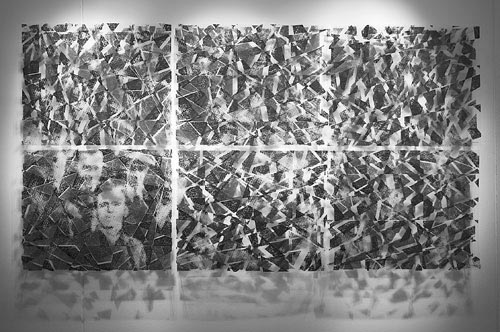

Untitled, 2004, photoinstallation, 102x154x12 cm
Codes of memory , 2004, photoinstallation
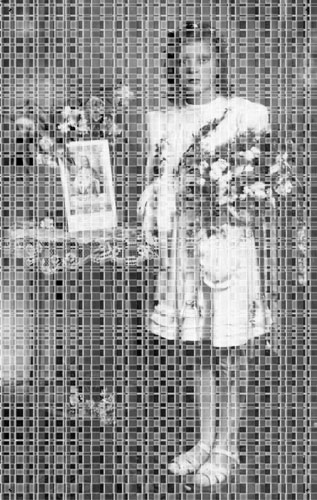
Codes of memory, 2004, photoinstallation fragment
From the Deconstruction
to the Reconstruction of an Image
Krzysztof Cichosz’s works are made up of intricate, internal relations of elements on which the content of their message is based. Complete images, reconstructed in the act of perception, arise from the seeming chaos of atomized particles that fill the surface of all the layers of the installation evenly. Each of these layers contains only a scrappy image; moreover, a very unusual one, because built not from structures and valour spots but of signs which possess their own, concrete meaning. Cichosz’s installations form a complex and hierarchical structure of meaning in which all elements are closely connected functionally and semantically.
Their close relations are a by-product of the author’s intended goal and the method used to achieve it. The image on each layer of the installation is produced by means of exposing a transparent positive through a negative and platescreen put together, which contains the structure of the work’s elements and covers one fourth of the surface of the negative with the original image. Subsequent expositions of the same negative, serving to produce the next three layers, are conducted by means of screens whose structure is based on the same element or elements as before and has been fashioned in such a way as to cover another one-fourth of the negative’s surface. In his latest works the author has decided to give up photochemical processes and manual manipulations and turn to digital treatment, which has not changed the final visual effect of the installations. The sum of the content of four layers of the work adds up to the content of the original, primary image. However, each layer analyzed separately does not allow us to make out what this original image represents. Its reconstruction can be achieved by the viewer only in the act of perception, when he combines all the layers.
Krzysztof Cichosz’s installations are highly intellectual works. Purely sensual perception cannot tell us much about them, as it is fragmentary, but the multi-layered intellectual activity of the viewer lets us reconstruct the primary image and move onto the next, higher cerebral level of contact with the work. After the recontruction of the image, the viewer at this stage discovers its other features he acknowledges the many layers of the work and the semiotic structure of each layer, recognizes individual elements of the structure and finally finds their semantic relation with the content or context of the original image. Having possessed this comprehensive knowledge, the viewer can go back and reconstruct the essence of the author’s meassage. Otherwise he will not be able to connect the content of the original image with the meaning of isolated and disconnected acts of inspection of the installation. One must penetrate the purely visual image in order to get to the core of the message.
2.
In the first period of his career Krzysztof Cichosz chiefly made use of images borrowed from history and directly connected with it with the history of photography (first photograph by J.N. Niépce that has survived until our times or a landscape by Ansel Adams); with social and political history (Infantry Charge…, 1993, or The Great Threesome, 1989; and with the history of art (S.I. Witkiewicz’s self-portrait). In For Marilyn, Andy, America… (1988) the recurring element from which we reconstruct the image is the symbol of a dollar, also conceived as the symbol of the commercialization of art. Associating it with Warhol’s work can be understood as a critical comment to his ambiguous attitude towards commercialization. The message of these works referred to those aspects or circumstances which were connected with the content of the work - or with its author. In most recent works by Cichosz the choice of original images has rather more to do with the author’s personal, individual reaction to contemporary, more universal problems and phenomena than those distanced events from the past he had recalled earlier. In his Declaration… (2008) he uses as a screen the UN’s text of the Universal Declaration of Human Rights. The reconstruction of the three images of tanks – Chinese, British and Russian – is achieved by putting together the layers whose each screen contains respectively Chinese, English and Russian translations of the Declaration’s text. In a general sense the Declaration is confronted with the image of the tanks which serve a completely different purpose than the glorious ideals of the Declaration.
3.
The multistage and technically varied operations Cichosz undertakes are not performed on the images produced by the author, but on ready-made, well-known images which have been functioning in the sphere of broadly conceived visual culture or in a narrower artistic field for a very long time. However, the author does not steal other people’s images in order to make his own work more valuable or worthy artistically. He rather makes use of them in such a way as to emphasize their obscure status of images functioning in our contemporary iconosphere, since they are reproductions of reproductions of original pictures published in handbooks, encyclopedias, academic treatises, in newspapers, magazines and recently on the Internet. Likewise, it is not their artistic form but the content that is the reason why the author uses somebody else’s pictures in his own works. Cichosz’s approach has nothing to do with �śthe archeology of photography” which strives to restore personal, emotional meaning to other people’s forgotten images, the meaning connected with the author of the photograph or with the characters rendered in it. The images used in Cichosz’s works are well-known and their place in our culture is obvious. They belong to what Andre Malraux once called �śthe museum of the imagination” (�śLe Musée Imaginaire”) in which a constant rejuvenation takes place, a rejuvenation of a common cultural canon of images that affects our individual memory of them. Using the images that belong in modern culture, regardless of the time of their coming into being, Cichosz tries to enter into discourse not directly with those images but with those cultural problems and phenomena that are important to him. He feels that to deal with them is his responsibility as an artist who is, in his opinion, an indispensable kind of social servant.
In order to communicate this content and enter this discourse, Cichosz carries out the deconstruction of the original image which is a very important part of the process of the production of his works. The results of such a deconstruction are a direct source of the visual structure of the work’s individual layers that later help the viewer to reconstruct the whole image in gallery space. Paradoxically, in this case decomposition serves the cause of reconstruction. Although both operations are performed on the same original image, the images that we arrive at in effect are different. After deconstruction the image materializes, its material status is somehow intensified and the image is disintegrated into and onto separate layers in space. On the other hand, after reconstruction the image dematerializes because it exists only in the mind of the viewer - it can be found neither between the individual layers of the work nor on them. It ceases to be a physical and material entity and becomes a mental entity. This unique sublimation of the image, its relocation from the material to the immaterial, purely mental ontological level, is an intriguing result of these apparently contradictory processes of deconstruction and reconstruction.
In the process of deconstruction the content of the image undergoes a far-reaching reduction and is broken down into atomized elements. In each layer of the installation, places which are their traces are empty - there is nothing in them. Thus the continuity of the primary image is broken. Its reconstruction which takes place in the act of perception restores the continuity of content of the primary image, but adds something more to it, something that results from the relation between the meaning of each single element of the screen and the whole of the image.
The reading of the message does not take place solely during the act of perception of the whole reconstructed picture, although it is its condition sine qua non. It begins at the moment when we become aware of the meanings of individual elements of the installation’s structure and their connection with the content of the reconstructed image.
For Krzysztof Cichosz as the author it is deconstruction that seems most important (he even stresses this in the title of this exhibition), because that is what his creative operations concentrate on. However, for the viewer it is reconstruction that is crucial because its effects allow us to see the image, read its content and grasp the message of the whole work. Deconstruction and reconstruction remain in a dialectical relation here whose consequence is the content of the message, based on a morphologically and semantically complex structure of the installation.
Cichosz uses digital techniques in his latest installations not only to work on the image or produce digital print-outs of separate layers, but also to facilitate and quicken his manipulations of the image. They also inspire and provoke the author to extend the process of deconstruction, but most of all they deepen the deconstruction of the image, whose atomization is achieved by means of the structure of the given screen.
4.
The reconstruction of the image that takes place in the viewer’s mind requires the fulfillment of a few conditions during the perception of the work. The viewer must find such a vantage point from which he can look at the installation, see that the layers overlap in space and thus produce an image. The viewer must find this point on his own because the complete image cannot be seen from just anywhere. The installation forces us to be physically active as we have to keep moving around it in order to find the correct vantage point. When we move away from the installation, its structures combine into one image, and when we get closer to it, smaller and smaller details are revealed, until we are left with the tiniest basic meaningful element. However, in the latter case the image disappears from view, disintegrates and reveals its deconstruction. Still it is necessary to get closer to the work if we want to examine its complex structure, find the basic elements that constitute the image and read its meaning. Finding the correct vantage point conditions our reconstruction of the image and lets us relate its content to the content of the primary image.
The process of reconstruction of Krzysztof Cichosz’s installations is dynamic and their static and passive contemplation does not give us a chance to grasp the essence of the message. The images and their hidden content are best revealed �śon the move”, during the act of perception of the spatial phenomena those installations truly are; their total perception is possible only in expositional space.
The viewer’s physical, motorial activity must be accompanied by mental activity so that the work will not only be perceived but also appreciated in its complexity, including the meanings of all elements, and then understood in terms of relations between them. The first stage of perception leads to the reconstruction of the primary image situated in space on four parallel layers of the installation. This phase is sensual in character and results in the reconstruction of the whole image in the viewer’s mind. The second stage, most important for the reading of the message, is purely mental. It is based on numerous operations in which the viewer uses his visual knowledge, individual memory of images and readiness to enter into discourse with the work. If such a discourse is to take place, we have to connect the basic elementsign, and the structure of each layer, with the content of the image, composed of all four overlapping layers. In order to do this, the basic, recurring element or group of elements must be read in its symbolic and semantic sense. This is because intentional authorial content is built upon semantic relations and tensions between them by means of combining the meaning of a given element with the content of the whole visual structure.
5.
In those deconstructive and reconstructive processes one more opposition is revealed, having to do with the attitude of the author and somewhat more fundamental. Namely, it is the opposition between the attitude of a postmodernist and a modernist. Deconstruction is one of the means of the postmodernist method. In Cichosz’s works reconstruction, to which the process of perception of deconstruction’s effects unavoidably leads, denies the postmodern mistrust of the significance of actions that ascribe new meanings and values to a given work. A postmodernist would not have done much more than produced the four layers of the installation. He would have put them together, clearly showing the effects of the images’ deconstruction into meaningful elements, but at the same time he would have also pointed out the impossibility of reading the complete content of the deconstructed image from the four layers of the installation. Although its visual matter is totally contained in individual layers, it cannot be grasped if we analyze each layer separately. However, Cichosz does not contend himself merely with decontruction which would probably satisfy a postmodern artist. He uses deconstruction to give depth to the overall, universal character of the image’s content by depriving it of its �śatomic” content, to be found in all the details of a veristic and precise photographic image. As far as the original image is concerned, Cichosz is interested only in its overall content. The result of his deconstructive operations on the image is the reduction of content to problems and phenomena which are important for the author. Only then does the content, generalized and universalized in its function, become the basis for the formulation of the author’s own message, contained in the work as a whole. The meaning of the primary image reduced in such a way is but a fragment of its intricate visual structure. Its linking with the meaning of aany single element of the layers’ structure produces new and original values, contained in the message of the work. This last aspect, namely the production of new and original values, also decidedly distinguishes Cichosz from postmodern artists.
Thus we can say that Krzysztof Cichosz’s art includes some elements of the postmodernist method that questions the sense and even possibility of producing new and original works, as he performs his creative operations not on his own, but someone else’s images, borrowed from history, from �śthe museum of imagination” of our collective memory of images. Postmodernism which declares the end of �śgrand narratives”, based on universal values, combines the disbelief in the possibility of producing totally new works with rejection of art which holds on to permanent and universal values. In his own works Cichosz, especially recently, refers precisely to those values in which he has always believed and still believes, thus consistently continuing down the chosen path. He changed his attitude from the beginning of his career, when he had employed elements of postmodern aesthetics, becoming, as he himself says, a neomodernist who is well aware of the achievements of the previous period in the history of art, recognizes them and returns to certain modernist values and beliefs, but on a different level of his own art’s evolution - which takes place in different times.
6.
In spite of the fact that the foundations of his method remain unchanged, Cichosz’s art evolves along with the evolution of his methods. I have in mind the content of the message of his individual works (which recently has more to do with the author’s personal reaction to various contemporary problems and events), as well as a purely technological aspect of their production, i.e. the use of digital techniques at different stages of the making of the work.
The range of these two operations – deconstruction and reconstruction – has been expanded in Cichosz’s latest works, presented at the current exhibition. He has developed both the method used to deconstruct the image, as well as new methods of its reconstruction. For example, he has written special computer programmes which randomly generate not only a given single element but also assign it a place within the structure of an individual layer. This stochastic mechanism expands the capability of deconstruction and imposes mathematical order on the four-layer structure which results from the calculus of probability. It also objectivizes this stage of the creative process which becomes a carrier of precious value in Cichosz’s highly intellectualized attitude. In his Codes of Memory (2003), for instance, the screen is composed of randomly modified images of human genetic code.
This change is accompanied by new operations connected with the process of the image’s reconstruction. In a few of his recent works (like Untitled, 2004, and Declaration…) Cichosz used the method of shifting the position of the image on each layer – and the shift is different in each image field. Such a move results in the illegibility of the whole picture that comes into being when the installation is viewed as a whole, while the image in individual fields can only be seen from different vantage points. Therefore, we no more have the one vantage point from which the whole picture can be seen. Each fragment in a square field can be seen only in turn, separately, because those fragments can be combined into a whole only from four specific vantage points. From each of such points we can only see one fragment of an image contained in a given square of the field and only if we look at it at a particular angle, specific to each fragment. Layers of neighbouring images do not make up a legible and recognizable fragment of the original image and if we look at them from an improper angle we get an illegible, almost abstract image. So at a given point and time the viewer sees only parts of the picture. If we change the angle, other fragments of the image will be revealed. A static, passive viewer will not see all the fragments and will not be able to reconstruct the whole work on the basis of its parts. The physical activity of the viewer and his moving around the installation is absolutely necessary if he is to see all the fragments of the image and if the work is to manifest itself to him as a work complete in terms of form and content. Therefore, the viewer has to remember subsequent fragments of the image seen from different points of view. If he remembers those fragments, he has a chance to mentally reconstruct the whole of the original image. However, these works demand not only physical activity on the part of the viewer - his intellectual activity on two levels is also necessary. The first level has to do with his remembering of the fragments of pictures, while the second one with their mental, not sensual combination, and reconstruction into a complete whole.
Cichosz’s installations draw the viewer’s attention thanks to their distinctiveness and surprise him with relations between the flatness of a photographic image and the depth of the overall visual effect. Relations between their material concreteness and the ephemerality of the image reconstructed in the viewer’s mind are equally surprising. However, these effects are not the aim but a means the author uses to arrest the viewer’s attention for a little longer than a passing glance and to make him examine the problems tackled in his works more closely. Sensual experience is not enough to penetrate those installations and to grasp their semantic message. Comprehensive reception of these works without making an intellectual effort is impossible.
7.
Krzysztof Cichosz’s method is so unique and personal that it is hard to compare to any other technique. Moreover, it is used extremely consistently and serves to confront problems important for the author, but also for us, viewers. Cichosz has never bowed to any artistic fads of the past twenty five years, which is quite rare in contemporary art. Consistency, being an important element of his artistic stance, also applies to the propositions and aims adopted by the author a long time ago. He remains faithful to them as he remains faithful to his method which turned out to be open, effective and universal and does not constrain the author in the shaping of the work’s form or content.
Krzysztof Cichosz has always been a very demanding artist, setting high standards both for himself and his spectators, which is a value in itself. The viewer, as we have observed, must be doubly active during the perception of his works, which seems to have a universal metaphorical meaning as far as our contact with all artistic phenomena is concerned - because in this way Cichosz points out that we can never remain passive when we are dealing with art. He demands that the viewer be active and open to the enigma concealed in an artwork. He also wants us to be open to unconventional form. Its discovery does not depend only on overcoming the complexity of form which is not employed here to make the work attractive and is not something supposed to be something new and original merely for its own sake. Form is not an autotelic aim in itself - it just carries the message. The road leading to this illumination is a value in itself and a precious effect of the viewer’s intellectual activity inspired by the work. On the other hand, the results of such a discovery are a condition of our reaching the next, deeper and most essential level of the reception of the work’s message, to be found not in the literal, visual content of its individual elements but in the intellectual perception of their mutual internal relations.
Krzysztof Cichosz also seems to be saying that any positive effect of our contact with art does not depend exclusively on the artist’s efforts, even if he produces his work very responsibly, carefully and seriously. It also depends on the viewer, who has to adopt a similar attitude. It is the combination of the artist’s and the viewer’s efforts that gives meaning to art and is the source of our experiencing authentic and deep artistic spiritual values.
Lech Lechowicz
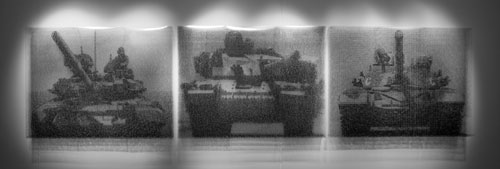
Declaration..., 2008, photoinstallation, 77x310x12 cm
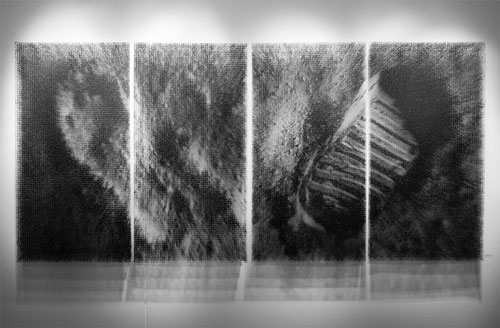
Traces, 2006, photoinstallation, 100x208x12 cm
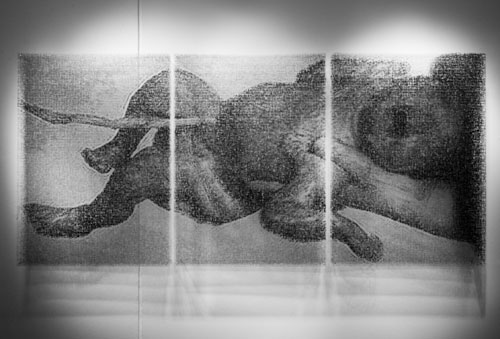
Tabula rasa, 2008, photoinstallation, 70x154x12 cm
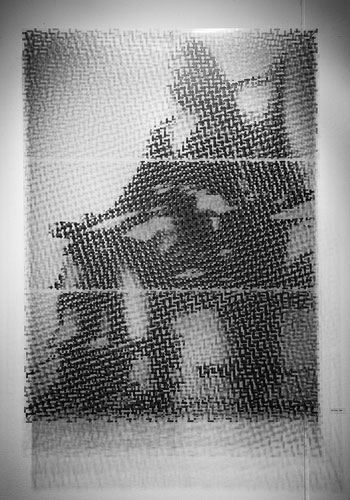
Projekt dofinansowany ze środków Ministerstwa Kultury
i Dziedzictwa Narodowego
w ramach programu operacyjnego Promocja twórczości
i Dziedzictwa Narodowego
w ramach programu operacyjnego Promocja twórczości
Copyright ©2008 Galeria FF ŁDK, Krzysztof Cichosz, Lech Lechowicz
